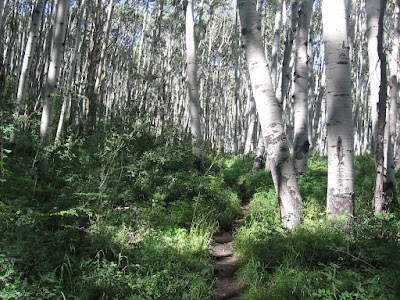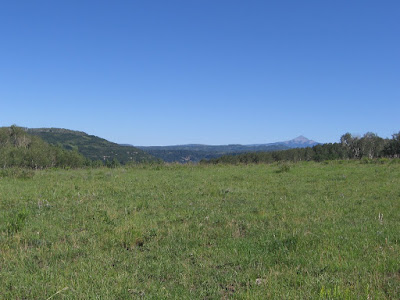The
McPhee Park Old Growth Ponderosa Trail is an unofficial route in the San Juan National Forest just west of Dolores in southwest Colorado. The route starts at the junction of
Forest Roads 531 and 526 about seven miles past the turnoff for the House Creek Recreation Area on McPhee Reservoir.

According to the antique sign, in 1925 a sample of virgin Ponderosa Pine was set aside. This point is only about 10 minutes of walking down road 531.
The road is well graded and this park like spot can be easily driven to. There is not a sign along the main road 526, so you have to be alert and know to turn on 531.

Some of the Ponderosas are noticeably bigger around and taller here than in other parts of the forest. There are also some very tall dead trees that are important habitat for woodpeckers and other birds. These large crags are often missing in managed forests.
Ponderosa pine has a long clear trunk and a high short open crown. It averages 42 inches in diameter and 165 feet tall at maturity. Ponderosa pine reaches maturity in 300 to 400 years.

As the trees reach maturity, the bark thickens to as much as 4 inches and breaks into large, flat, yellow-brown, scaly-topped plates separated by deep furrows. Old trees have a characteristic yellow bark and are locally named
Yellow Pine.
The wood is highly desirable, light in weight, rather hard, strong, and relatively fine-grained. The road past these huge trees gets rougher as you continue south and swings around back north to make an easy
loop trail that takes about 45 minutes to walk.

The route follows along the rim of a creek valley thick with Ponderosa and a few Aspens. Ponderosa pine is common in mountain and plateau areas at elevations between 5,700 and 8,900 feet. It develops a taproot early in life, which helps it to survive extended drought periods, especially long, dry summers.

Near the end of the loop there is a small constructed pond and an open meadow. The Ponderosa have male and female cones on the same tree. The male cones are small, yellowish, and in clusters. Female cones average 4 inches in length when mature.
The tips of the cone scales are armed with short, sharp, out curved prickles. The female cones, like all pines, require two growing seasons to mature.
The road gets a little better and climbs back up to Road 531 very near the junction with Road 526. I walked the loop twice in 1:30 hours.





 Dirt bikes and horses can also use this trail. The Emerson Trail Head area used to be a campground, but has been retired for camping for the last 10 years or so.
Dirt bikes and horses can also use this trail. The Emerson Trail Head area used to be a campground, but has been retired for camping for the last 10 years or so.










 The forest tower that I know of in that area is the Benchmark Lookout Tower. The road up to the tower overlooks Narraguinnep Canyon from the north. I visited the tower in July 2008 while looking for hiking opportunities in the area. I and my dogs were invited to climb up and I had an opportunity to talk to the lady working in the tower. I was startled to learn that she had spent every summer in this remote elevated room for nearly 20 years.
The forest tower that I know of in that area is the Benchmark Lookout Tower. The road up to the tower overlooks Narraguinnep Canyon from the north. I visited the tower in July 2008 while looking for hiking opportunities in the area. I and my dogs were invited to climb up and I had an opportunity to talk to the lady working in the tower. I was startled to learn that she had spent every summer in this remote elevated room for nearly 20 years.






























